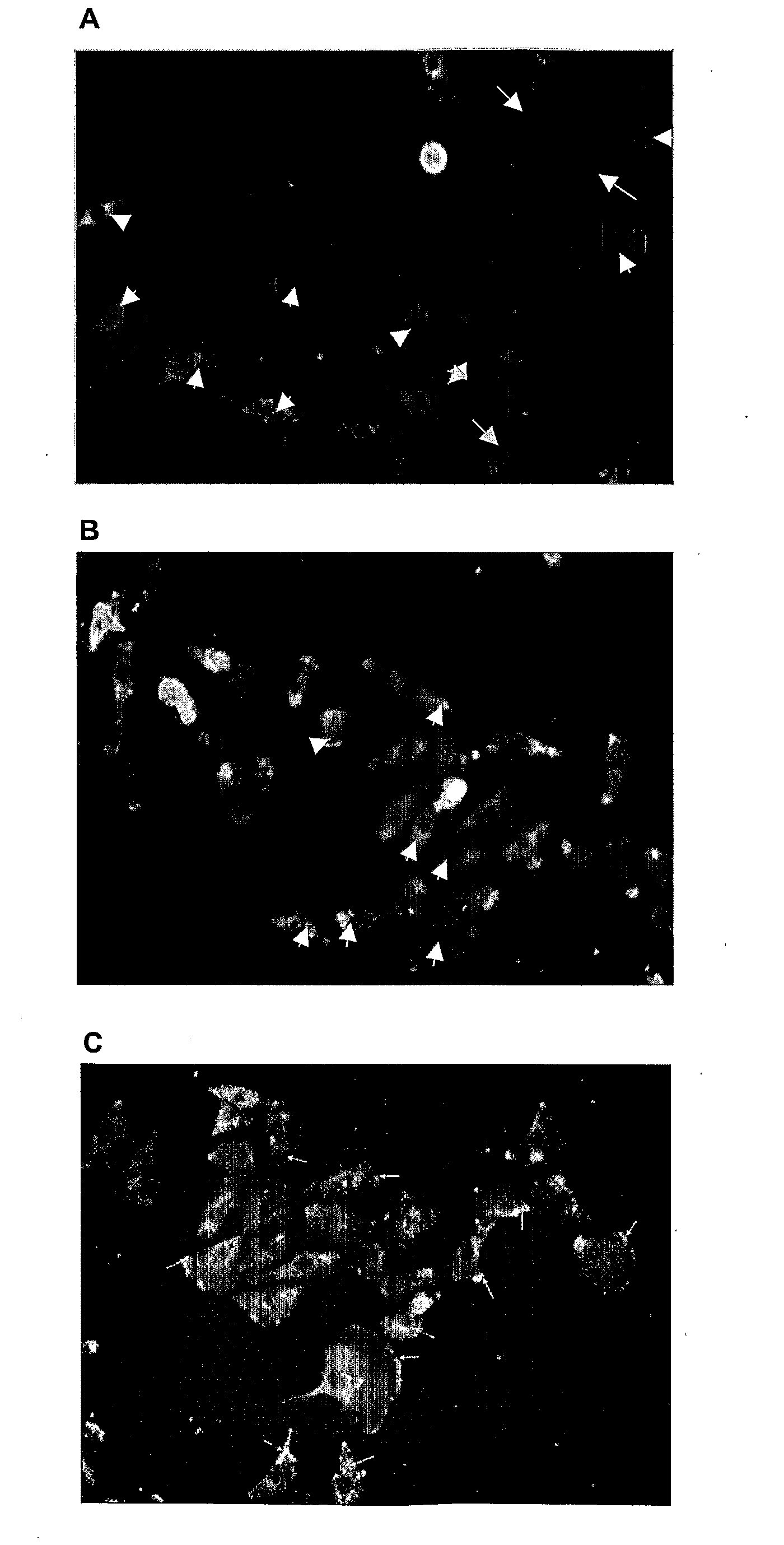Inhibitors of protein kinase c isoforms and uses thereof
- Summary
- Abstract
- Description
- Claims
- Application Information
AI Technical Summary
Benefits of technology
Problems solved by technology
Method used
Image
Examples
example 1
In Vitro Competition Experiments with PREs and PKC-α: Protocol A
[0413]The ability of the PRE 1, 2 and 3 (see Table 3 above) to interfere with the binding of a PKC-α-specific polyclonal antibody to PKC-α was determined using the following protocol.
[0414]Cell lysates from either IMR-32 (human neuroblastoma) cells or C6Cx43 cells (rat glioma transfected cells overexpressing connexin 43) were obtained using standard protocols and the proteins of the lysate were separated by SDS PAGE electrophoresis and electrotransferred onto a nitrocellulose membrane. The membrane was incubated for 30 minutes in blocking buffer (TBST) containing the test peptide at either 5× or 20× the concentrations of the primary antibody. A primary polyclonal antibody specific for PKC-α (Santa Cruz Biotechnology, Inc., CA) was then added (15 μg / ml) and the membrane incubated for a further 45 minutes. Finally, the primary antibody was detected with a secondary antibody conjugated to alkaline phosphatase using standar...
example 2
In Vitro Competition Experiments with PREs and PKC-β: Protocol A
[0417]Peptides PRE 1, PRE 2 and PRE 3 (see Table 4) were tested for their ability to interfere with the binding of a PKC-β-specific polyclonal antibody (Santa Cruz Biotechnology, Inc.) to PKC-β using the general protocol described in Example 1. The results are shown in Table 7 and show that there is some cross reactivity between both PRE 1 and PRE 2 and PKC-β. It is worth noting in this regard that PKC-α and PKC-β belong to the same sub-group of PKCs (cPKCs). The effect with PKC-β, however, is fairly limited indicating that these two peptides have a reasonable degree of specificity for PKC-α. Under these assay conditions, PRE 3 did not show an effect on antibody binding to PKC-β.
TABLE 7Inhibition of Antibody Binding to PKC-β by PRE 1,PRE 2 and PRE 3 in IMR-32 Neuroblastoma Cells: Protocol ARelative IntensityInhibitionPeptideBand Intensity(%)(%)None (control)1.160——PRE 1 (75 μg)0.82571.128.9(300 μg)0.52845.554.5PRE 2 (75...
example 3
In Vitro Competition Experiments with PREs and PKC-α: Protocol B
[0418]The ability of the peptides PRE 2 and PRE 3 (see Table 4) to interfere with the binding of a PKC-α-specific polyclonal antibody (Santa Cruz Biotechnology, Inc.) to PKC-α was determined using a modified version of the protocol outlined above in which the test peptide was added directly to the cell extract prior to electrophoresis at a concentration of either 5× or 15× the concentration of the protein applied to each well of the gel for the Western blots (20 μg).
[0419]The results are shown in Table 8. The results show that the interaction between each peptide and PKC-α was sufficiently strong to prevent dissociation during electrophoresis and that both PRE 2 and PRE 3 effectively interfered with PKC-α antibody binding to PKC-α. PRE 3 was more efficient than PRE 2 under these assay conditions.
TABLE 8Inhibition of Antibody Binding to PKC-α by PRE 2 andPRE 3 in IMR-32 Neuroblastoma Cells: Protocol BRelative IntensityPe...
PUM
| Property | Measurement | Unit |
|---|---|---|
| Temperature | aaaaa | aaaaa |
| Temperature | aaaaa | aaaaa |
| Temperature | aaaaa | aaaaa |
Abstract
Description
Claims
Application Information
 Login to View More
Login to View More - R&D
- Intellectual Property
- Life Sciences
- Materials
- Tech Scout
- Unparalleled Data Quality
- Higher Quality Content
- 60% Fewer Hallucinations
Browse by: Latest US Patents, China's latest patents, Technical Efficacy Thesaurus, Application Domain, Technology Topic, Popular Technical Reports.
© 2025 PatSnap. All rights reserved.Legal|Privacy policy|Modern Slavery Act Transparency Statement|Sitemap|About US| Contact US: help@patsnap.com



